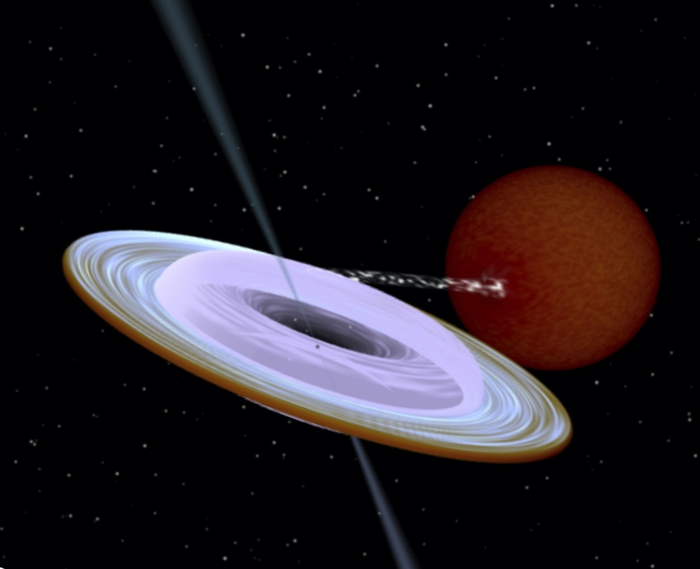Scientists find strange black hole spinning on its side
The unexpected discovery could change how astronomers study the mysterious cosmic holes

Scientists have discovered a strange black hole spinning on its side, an unexpected finding that could change how astronomers study the mysterious cosmic holes in reality.
In a new study published in the journal Science, scientists show for the first time a misalignment between a black hole’s spin axis and its orbital axis, a finding that could change our understanding of how black holes form and behave.
“This finding challenges current theoretical models of black hole formation," said professor Svetlana Beryugina in a statement. An astrophysicist and director of the Leibniz Institute for Solar Physics, Dr Berdyugina led the international team of astronomers behind the paper.
MAXI J1820+070, the subject of Dr Berdyugina and her team’s study, is a binary star system consisting of a black hole and a companion star around 10,000 light years from Earth.
Often, a black hole’s powerful gravity will begin to pull material from a companion star in such a system, and that material will begin to flatten out and spiral as it falls into the black hole, like water spinning down a drain.
Known as an accretion disk, this flattened, whirling spiral aligns with the orbital plane of the black hole and its companion star.
But unlike water around a drain, this material whirls so rapidly that it heats up, emitting light and X-rays.
And in the case of black holes like the one in MAXI J1820+070, some of the infalling materials get blasted away by this radiation, forming powerful jets of material shooting away from the black hole at close to the speed of light. Called relativistic jets, these streams of matter are emitted along the black holes axis of spin.
When Dr Berdyugina and her team studied the relativistic jets and light coming from MAXI J1820+070, they found the black hole’s axis of spin did not match its orbital axis and that of the accretion disk: The two were misaligned by at least 40 degrees, a much larger difference than scientists believed existed in such star systems.
To use the limited analogy of a bathtub drain, this is like a drain that’s angled 40 degrees on its side instead of lying flat in the bottom of the tub.
The researchers believe that the misalignment must have occurred at the time the black hole formed since the process of accretion typically brings a black hole’s axis of spin and orbital axis into closer alignment.
To make the discovery, Berdyugina and her team used a special instrument for measuring polarized light, the angle of rotation of light, installed on the Nordic Optical Telescope in La Palma, Spain. Measuring the polarization of light coming from MAXI J1820+070 and combining it with previous measurements of the black hoe’s relativist jets were what allowed the team to measure the misalignment in the black hole’s spin axis and orbital axis with precision.
Going forward, scientists will look to see if similar misalignments exist in other binary star systems, which could require astrophysicists to update their models of black hole behavior.
“Determining the orbital orientation of black holes based on polarization opens a new path to understanding their formation and physics," Dr Berdyugina said in a statement.
Subscribe to Independent Premium to bookmark this article
Want to bookmark your favourite articles and stories to read or reference later? Start your Independent Premium subscription today.

Join our commenting forum
Join thought-provoking conversations, follow other Independent readers and see their replies